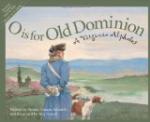And can any modern ranges bake quite as perfectly as did those colonial brick ovens? After a fire of oven-wood had flamed for hours in one of those brick chambers, and at last the iron door had been opened and the ashes swept out, the heated interior was ready to receive the meats and breads and pastry, and to bake them “to a turn.”
When, in the restoration of Mount Vernon, the kitchen was reached, recourse was had to Shirley’s kitchen. Drawings were made of an unusual colonial table, of a pair of andirons with hooks for spits to rest on, and of several other old-time cookery appointments; and, from these drawings, were constructed the duplicates that are now in the Mount Vernon kitchen.
It was on our way from the kitchen to the mansion that we came upon another visitor to Shirley. She was short and round and black and smiling and “feelin’ tol’ble, thank you, ma’am.” This, we learned, was Aunt Patsy. She had “jes heard dat Miss Marion done come home”; and so, arrayed in her best clothes including a spotless checked apron, she had come to “de gre’t house” to pay her respects to Mrs. Oliver.
Drawn out somewhat for our benefit, she gave her views upon the subject of matrimony.
“I been married five times,” she said. We were not particularly surprised at that; but were scarcely prepared for the added statement, “an’ I done had two husban’s.”
However, no one could fail to understand Aunt Patsy’s position, and to heartily agree with her, when she came to explain her marital paradox.
“De way ‘tis is dis way,” she said. “What I calls a husban’ is one dat goes out, he do, an’ gethahs up” (here, a sweeping gesture with the apron, suggestive of lavish ingathering), “gethahs up things an’ brings ‘em in to me. But what I calls havin’ a man aroun’ is whar he sets by de fiah and smokes he pipe, while I goes out an’ wuks an’ brings things home, an’ he eats what I gives him. An’ dat’s how come I been married five times, an’ I done had two husban’s.”
[Illustration: Brick oven in the bake-room.]
Before the old oak chest was opened for us, that day at Shirley, we knew that this colonial home was rich in antique silver. Yet, the family speak of the many pieces as “remnants,” because of the still greater number lost at the time of the war. The plate was sent for safe-keeping to a man in Richmond who was afterward able to account for but a small part of it. Evidently, the Hills and the Carters went far in following the old colonial custom of investing in household silver. And as an investment the purchase of this ware was largely regarded in those days; family plate being deemed one of the best forms in which to hold surplus wealth.
Different periods are represented in the old pieces yet remaining at Shirley. There are the graceful, classic types of the days of the Georges; the earlier ornate, rococo forms; and the yet earlier massive styles of the time of Queen Anne and long before. Among the most ancient pieces, are heavy tankards that remind one of the long ago, when such great communal cups went round from merry lip to merry lip—microbes all unknown. The numerous spoons too speak of the time when there were no forks to share their labours. Most of the silver remaining to-day is engraved with the coat of arms of the Carters.




